NVIDIA's GeForce 8800 (G80): GPUs Re-architected for DirectX 10
by Anand Lal Shimpi & Derek Wilson on November 8, 2006 6:01 PM EST- Posted in
- GPUs
The 680i Platform
Alongside the GeForce 8800 GTX and GTS, NVIDIA is launching a brand new chipset for Intel processors, the nForce 680i (and 650i SLI and Ultra). Our own Wesley Fink has published an in-depth look at the new chipset, but we felt the release significant enough to comment on some of its features here in this review.
For the most part, competing with Intel for its chipset business is an effort in futility. The companies that have tried have ended up either segregated to the low end of the market or kept to an extremely small niche. The past has proven that it is simply very difficult for a company that isn't Intel to produce a better performing chipset for Intel processors.
The multi-GPU era has changed things a bit, because now all of the sudden there's a new feature that Intel can't simply support on its chipsets. It took a while but ATI eventually allowed Intel to support CrossFire on its chipsets, but who knows how long that will last given ATI's new owner. While ATI caved in and supported Intel, NVIDIA would not capitulate. NVIDIA is like a mini-Intel and just like the big version, it doesn't play well with others. Licensing SLI for use on Intel chipsets was simply not in the cards; instead NVIDIA used SLI support as a reason for Intel users to consider NVIDIA chipsets. As NVIDIA continues to have the stronger multi-GPU lineup (although ATI has recently started fixing some of its problems with CrossFire), the SLI brand remains strong.
Although behaving like a veteran chipset manufacturer, NVIDIA is still a relative newcomer to the chipset business, but one thing we have seen from the boys in green is that they definitely learn from their mistakes. Dating back to the original nForce chipset, NVIDIA fell flat on its face with its first attempt at PC core logic, but bounced back to topple VIA with its nForce2 chipset. And it's that nForce to nForce2 transition that we're seeing here again with NVIDIA's nForce 680i SLI.
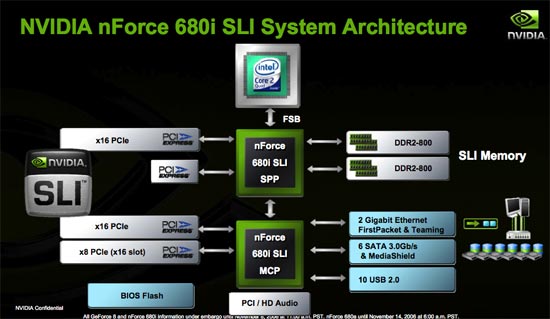
The 680i SLI is strictly a high end chipset, as the lower end of the market will still be serviced by NVIDIA's 570 SLI. The 680i supports all of the checkbox features: 1066MHz FSB (with unofficial support for higher speeds), dual channel DDR2-800, two PCIe x16 slots, one PCIe x8, 2 GbE ports, 6 SATA, 10 USB and HD Audio.
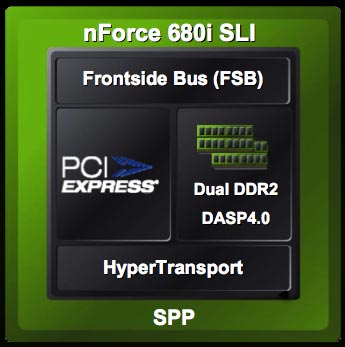
There are some pretty unique features about the new chipset. For starters it is the first NVIDIA core logic to be built on a 90nm process. The 680i SPP (aka North Bridge) is built on TSMC's 90nm process and thus ends up running cooler and can be overclocked more than NVIDIA's previous offerings in the area. The South Bridge (680i MCP) is still a 130nm chip but its functions are far less critical than those of the North Bridge.
In the 680i SPP is an updated version of NVIDIA's pre-fetching core called DASP. The major change to the 680i's DASP is that it is optimized for the memory access patterns of Conroe and Kentsfield which apparently are very different from NetBurst CPUs of the past. Given the aggressive prefetching done by the new Core processors and the large shared L2 cache, it isn't surprising to find out that memory controllers tuned to older Intel processors might not be best optimized for Core.
The primary function of the 680i's DASP is to examine memory access patterns and prefetch data into a local buffer that it thinks the processor will need at a later point in time. The updated version of DASP prefetches one cache line (64B) at a time into an internal buffer, although NVIDIA wouldn't disclose the size of the buffer.
We couldn't get much more information on DASP 4.0 from NVIDIA other than it supports prioritizing of reads over writes (to avoid read-to-write delays from random memory requests) and that a number of proprietary algorithms are used to make sure that prefetching doesn't occur when the CPU actually needs data from the memory controller.
Overclocking is a very large part of the new 680i chipset, and Wes' review of it goes into great detail about what exactly is possible with this new platform. For us, the other interesting part of the 680i platform is that, for the first time, NVIDIA is allowing its partners to sell NVIDIA engineered and designed 680i motherboards.
It has often been the case that a chipset maker's reference board has far more bells and whistles than anything its motherboard partners actually sell on the market. NVIDIA was growing weary of this being the case and instead effectively engineered a reference board that could be sold in retail.
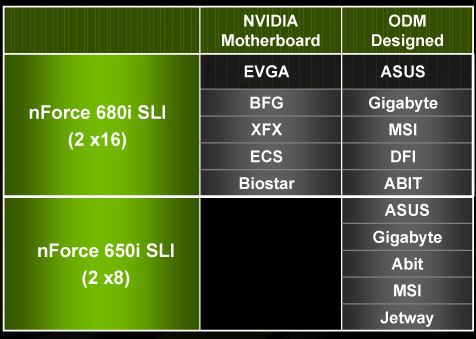
Motherboard makers can still choose to design their own 680i boards, but some have opted to simply rebrand NVIDIA's design.
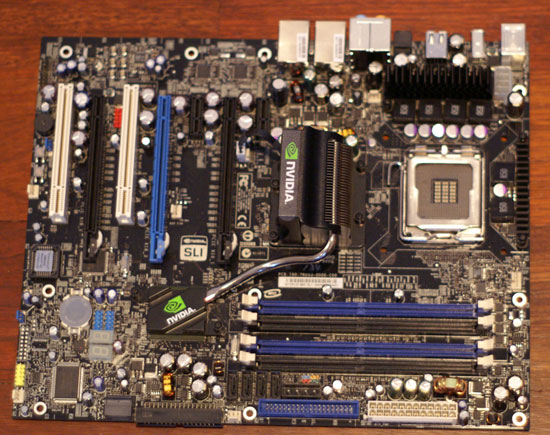
We ran all of our tests for this review on NVIDIA's nForce 680i SLI motherboard; this particular one is branded by EVGA. We were extremely pleased with the stability, BIOS, attention to detail and overall performance of the 680i solution. The decision to introduce NVIDIA designed 680i boards also shows how far NVIDIA has come as a manufacturer; if you want something done right, you sometimes have to do it yourself, and that's exactly what NVIDIA decided to do here. Honestly, the only downside is its estimated cost of $229.
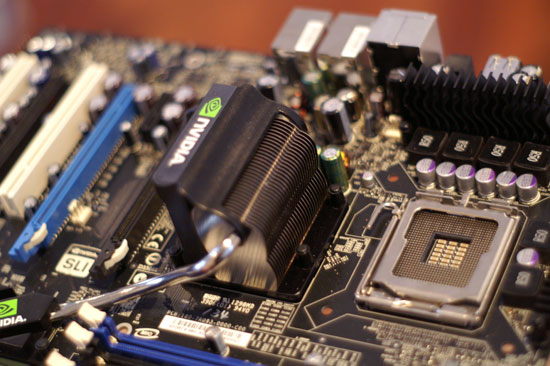
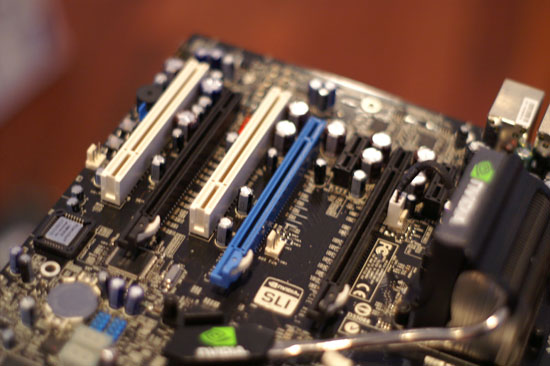
Three PCIe x16 slots (one is an x8 electrical)
NVIDIA is also introducing a lower cost 650i SLI chipset with only two x8 PCIe slots, but there will be no NVIDIA engineered boards available based on that chipset.










111 Comments
View All Comments
yyrkoon - Thursday, November 9, 2006 - link
If you're using Firefox, get, and install the extension "flashblock". Just did this myself today, tired of all the *animated* adds bothering me while reading articles.Sorry AT guys, but we've had this discussion before, and its realy annoying.
JarredWalton - Thursday, November 9, 2006 - link
Do you want to be able for us to continue as a site? Because ads support us. Anyway, his problem is related to not seeing images, so your comment about blocking ads via flashblock is completely off topic.yyrkoon - Thursday, November 9, 2006 - link
Of course I want you guys to continue on as a site, just wish it were possible without annoying flashing adds in a section where I'm trying to concentrate on the article.As for the off topic part, yeah, my bad, I mis-read the full post (bad habit). Feel free to edit or remove that post of mine :)
archcommus - Thursday, November 9, 2006 - link
What browser are you using?falc0ne - Thursday, November 9, 2006 - link
firefox 2.0JarredWalton - Thursday, November 9, 2006 - link
If Firefox, I know there's an option to block images not on the originating website. In this case, images come from image.anandtech.com while the article is on www.anandtech.com, so that my be the cause of your problems. IE7 and other browsers might have something similar, though I haven't ever looked. Other than that, perhaps some firewall or ad blocking software is to blame - it might be getting false positives?archcommus - Thursday, November 9, 2006 - link
Wow to Anandtech - another amazing, incredibly in-depth article. It is so obvious this site is run by dedicated professionals who have degrees in these fields versus most other review sites where the authors just take pictures of the product and run some benches. Articles like this keep the AT reader base very very strong.Also wow to the G80, obviously an amazing card. My question, is 450W the PSU requirement for the GTX only or for both the GTX and GTS? I ask because I currently have a 400W PSU and am wondering if it will be sufficient for next-gen DX10 class hardware, and I know I would not be buying the highest model card. I also only have one HDD and one optical drive in my system.
Yet another wow goes out to the R&D monetary investment - $475 million! It's amazing that that amount is even acceptable to nVidia, I can't believe the sales of such a high end, enthusiast-targeted card are great enough to warrant that.
JarredWalton - Thursday, November 9, 2006 - link
Sales of the lower end parts which will be based off G80 are what make it worthwhile, I would guess. As for PSU, I think that 450W is for the GTX, and more is probably a safe bet (550W would be in line with a high-end system these days, although 400W ought to suffice if it's a good quality 400W). You can see that the GTX tops out at just under 300W average system power draw with an X6800, so if you use an E6600 and don't overclock, a decent 400W ought to work. The GTX tops out around 260W average with the X6800, so theoretically even a decent 350W will work fine. Just remember to upgrade the PSU if you ever add other components.photoguy99 - Thursday, November 9, 2006 - link
I just wanted to second that thought -AT articles have incredible quality and depth at this point - you guys are doing great work.
It's actually getting embarrasing for some of your competing sites, I browsed the Tom's article and it had so much fluff and retread I had to stop.
Please don't forget the effort is noticed and appreciated.
shabby - Wednesday, November 8, 2006 - link
It wasnt mentioned in the review, but whats the purpose of the 2nd sli connector?